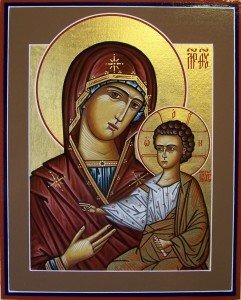 Our Church has a number of feasts which are dedicated to remembering events in the life of Mary, the Mother of God. They fall within what is called the Marian Group. The first, the Feast of the Presentation occurs forty days after the Nativity and, although it falls within the Marian Group, celebrates the presentation of Christ in the Temple and ritual purification of Mary according to Jewish custom. It first appeared in Jerusalem under Cyril where, like the other Cyrillian Feasts, it had a theological objective. The feast carries theophanic overtones. A line from Cyril’s own homily on this feast, “I see the infant and I recognize God,” is enough to clarify the Eastern Church’s view of the Presentation. By now Cyril’s anti-Arian bias is well known. However, when the feast was finally taken up two centuries later it was for purposes other than Cyril’s. Theophanes’ text, Chronographia, is practically our only direct historical evidence that Justinian instituted the Feast at Constantinople in the fifteenth year of his reign (542). Justinian had taken a commanding position in Church affairs, basing his ecclesiastical policy on the Council of Chalcedon. The Council condemned both Nestorianism and Monophysitism (belief that Jesus had only one single nature which was either divine or a synthesis of Divine and human), fixing the Church’s position between the two. The schismatic doctrine of Monophysitism arose in opposition to Nestorianism, claiming that Christ’s two natures became a single divine nature at the Incarnation. The Council of Chalcedon magnified the tension which already existed between Dyophysite Constantinople (i.e., two natures) and the Monophysite East to such a degree that espousing Monophysitism became a means of defying the Imperial government. For its part, the government, especially under Justinian, alternately persecuted and tried to win over the Monophysites.
Our Church has a number of feasts which are dedicated to remembering events in the life of Mary, the Mother of God. They fall within what is called the Marian Group. The first, the Feast of the Presentation occurs forty days after the Nativity and, although it falls within the Marian Group, celebrates the presentation of Christ in the Temple and ritual purification of Mary according to Jewish custom. It first appeared in Jerusalem under Cyril where, like the other Cyrillian Feasts, it had a theological objective. The feast carries theophanic overtones. A line from Cyril’s own homily on this feast, “I see the infant and I recognize God,” is enough to clarify the Eastern Church’s view of the Presentation. By now Cyril’s anti-Arian bias is well known. However, when the feast was finally taken up two centuries later it was for purposes other than Cyril’s. Theophanes’ text, Chronographia, is practically our only direct historical evidence that Justinian instituted the Feast at Constantinople in the fifteenth year of his reign (542). Justinian had taken a commanding position in Church affairs, basing his ecclesiastical policy on the Council of Chalcedon. The Council condemned both Nestorianism and Monophysitism (belief that Jesus had only one single nature which was either divine or a synthesis of Divine and human), fixing the Church’s position between the two. The schismatic doctrine of Monophysitism arose in opposition to Nestorianism, claiming that Christ’s two natures became a single divine nature at the Incarnation. The Council of Chalcedon magnified the tension which already existed between Dyophysite Constantinople (i.e., two natures) and the Monophysite East to such a degree that espousing Monophysitism became a means of defying the Imperial government. For its part, the government, especially under Justinian, alternately persecuted and tried to win over the Monophysites.
At the same time that Justinian instituted the Feast of the Presentation he began a new offensive to reconcile the Monophysites, hoping to gain their favor by contriving the condemnation of three Nestorianizing theologians. The new Feast may have been another of Justinian’s efforts to aggravate the Nestorians and thereby ingratiate himself with the Monophysites. Since it honored both Christ and the Theotokos it represents a somewhat diluted attempt to establish a major Marian feast in the Church calendar. However, as a truly Marian feast it was only a preclude to those that would follow.
The history of how our Church Feasts came about is fascinating to me.
